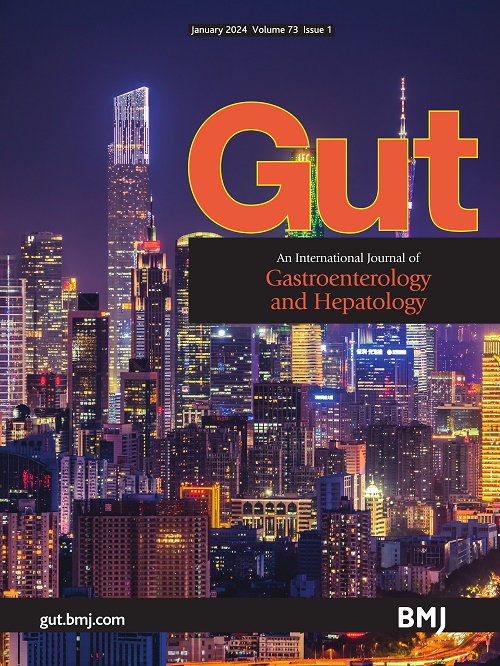50岁以下与50岁及以上人群息肉切除术后高危瘤变的比较风险
IF 25.8
1区 医学
Q1 GASTROENTEROLOGY & HEPATOLOGY
引用次数: 0
摘要
背景:当分析仅限于筛查目的的结肠镜检查时,有限的证据支持在0.05岁的个体中进行结肠镜检查。在筛查的个体中,在两个年龄组中,具有指数高风险病变的个体与息肉切除术后3年达到顶峰的相关性特别强,具有指数高风险腺瘤和高风险SPs的年轻人的hr (95% CI)分别为4.60(3.63至5.84)和5.59(3.89至8.03)。结论:年龄小于50岁的结肠镜筛查息肉切除术患者与年龄≥50岁的患者发生异时性肿瘤的风险相似,提示目前针对老年人制定的监测指南可能适用于年轻人。数据可能会从第三方获得,并且不会公开提供。本研究使用的电子健康记录数据是在医院系统许可下使用的,不能公开提供。本文章由计算机程序翻译,如有差异,请以英文原文为准。
Comparative risk of high-risk neoplasia after polypectomy among individuals aged below 50 years versus 50 years and older
Background Limited evidence supports colonoscopy surveillance practices among individuals aged <50 years. Objective To compare the risk of polyp recurrence and colorectal cancer (CRC) among young and old adults after polypectomy. Design We prospectively examined the risk of metachronous high-risk neoplasia, including high-risk adenoma, high-risk serrated polyp (SP) and CRC, according to index colonoscopy findings among individuals aged <50 years and ≥50 years who had received ≥1 follow-up colonoscopy in the Mass General Brigham Colonoscopy Cohort (2007–2023). We used a multivariable-adjusted Cox proportional hazards model to calculate HRs. Results We identified 37 576 adults without polyps, 26 693 with adenomas and 15 425 with SPs (including 8303 with synchronous adenomas and SPs). Among these 10 977 (29.2%), 3385 (12.7%) and 2659 (17.2%) were diagnosed before age 50 years, respectively. The associations between index polyp findings and subsequent risk of high-risk neoplasia were stronger for age <50 years than ≥50 years; however, such differences disappeared (Pheterogeneity>0.05) once the analysis was restricted to index colonoscopy for screening purposes only. Among screened individuals, in both age groups, the association was particularly strong for individuals with index high-risk lesions and peaked at 3 years after polypectomy, with HRs (95% CI) of 4.60 (3.63 to 5.84) and 5.59 (3.89 to 8.03) for young adults with index high-risk adenoma and high-risk SPs, respectively. Conclusion Patients undergoing polypectomy at a screening colonoscopy below age 50 years exhibited a similarly increased risk of metachronous neoplasia as those aged ≥50 years, suggesting that current surveillance guidelines developed in old adults may apply to young adults. Data may be obtained from a third party and are not publicly available. The electronic health record data used for this study are under license to the hospital system and cannot be made publicly available.
求助全文
通过发布文献求助,成功后即可免费获取论文全文。
去求助
来源期刊

Gut
医学-胃肠肝病学
CiteScore
45.70
自引率
2.40%
发文量
284
审稿时长
1.5 months
期刊介绍:
Gut is a renowned international journal specializing in gastroenterology and hepatology, known for its high-quality clinical research covering the alimentary tract, liver, biliary tree, and pancreas. It offers authoritative and current coverage across all aspects of gastroenterology and hepatology, featuring articles on emerging disease mechanisms and innovative diagnostic and therapeutic approaches authored by leading experts.
As the flagship journal of BMJ's gastroenterology portfolio, Gut is accompanied by two companion journals: Frontline Gastroenterology, focusing on education and practice-oriented papers, and BMJ Open Gastroenterology for open access original research.
 求助内容:
求助内容: 应助结果提醒方式:
应助结果提醒方式:


